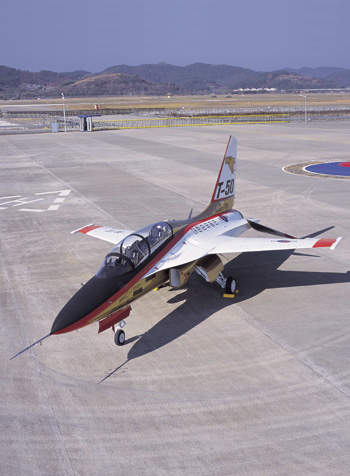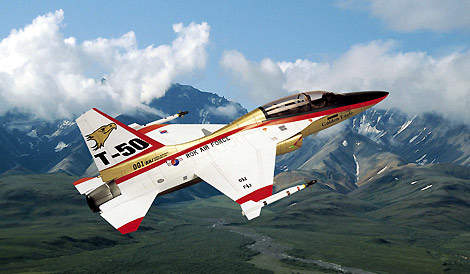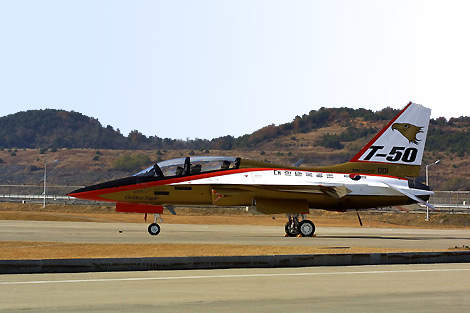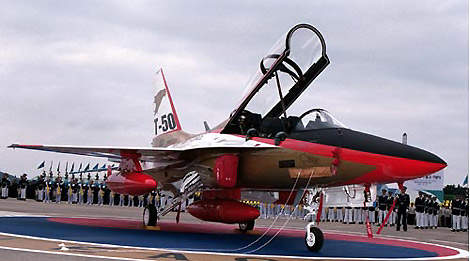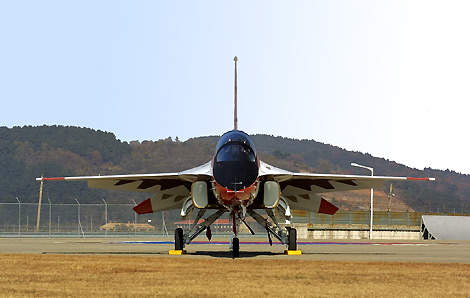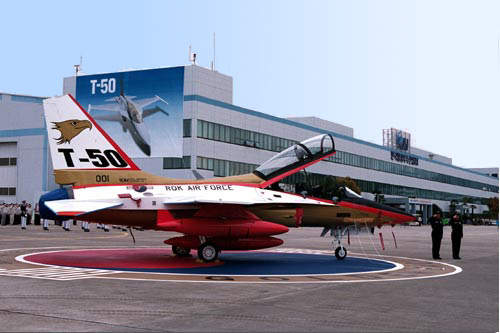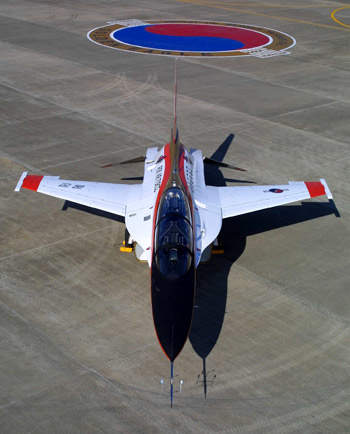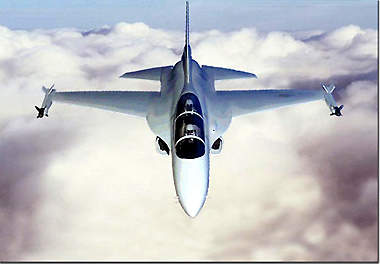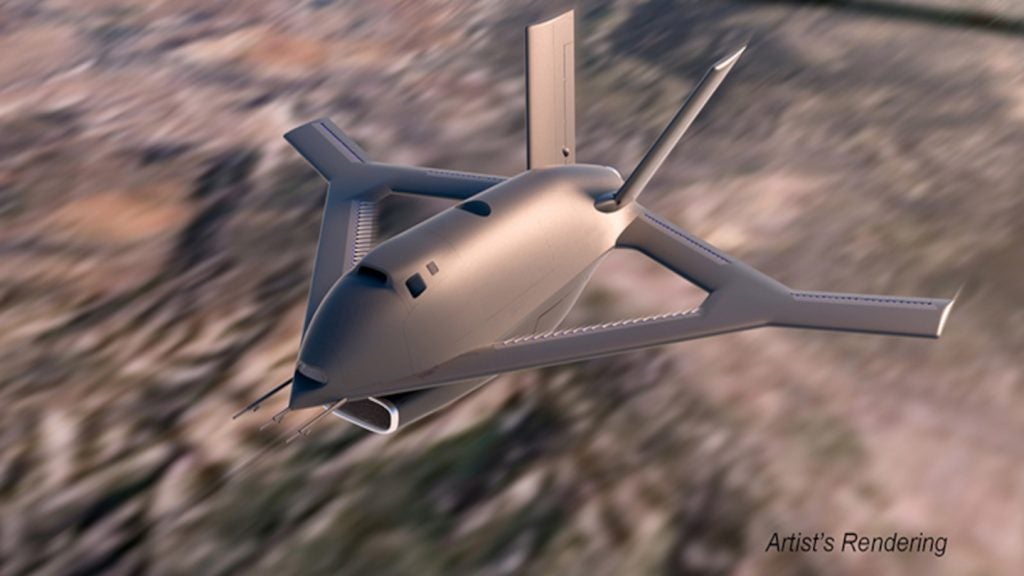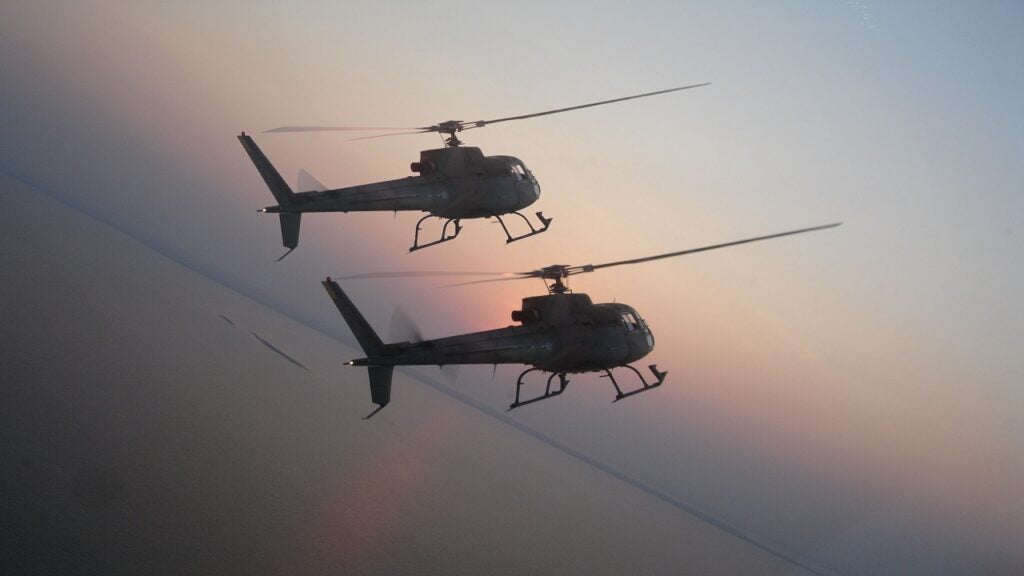The T-50 Golden Eagle, formerly known as the KTX-2, jet trainer and light attack aircraft was built for the Republic of Korea Air Force (RoKAF). The aircraft was developed in the T-50A advanced trainer and T-50B lead in fighter trainer versions.
The T-50 LIFT is called the A-50 by the RoKAF. The T-50 is designed to provide pilot training for current and next-generation fighters such as advanced F-16s, F-22s and the F-35 joint strike fighter.
T-50 Golden Eagle programme and orders
The first flight of the T-50 took place in August 2002. The RoKAF has a requirement for 50 T-50 trainers and 44 T-50 LIFTs. RoKAF placed a production contract for the first 25 T-50 in December 2003 and the first production aircraft was rolled out in August 2005.
The first two aircraft were delivered to RoKAF in December 2005 and entered service in April 2007. A total of 13 aircraft were deployed for training purposes in 2007.
Two squadrons (30 to 40 aircraft) began operations by 2008. The 50th and final T-50 was delivered to the RoKAF in May 2010.
One thousand flights have been completed in the test programme. The A-50 made its first flight in September 2003. A programme of weapon delivery flight testing was completed and deliveries of the A-50 began in 2009.
In December 2006, the RoKAF placed a second production contract for 50 T-50 and A-50 aircraft.
KAI developed a fighter version based on the T-50, called the FA-50 for the RoKAF, which has a requirement for 60 aircraft to replace the F-5.
In December 2011, KAI signed a production contract with Defense Acquisition Programme Administration (DAPA) to deliver 20 FA-50 aircraft by 2014. The aircraft obtained type certificate in November 2012. The FA-50 is fitted with air-to-air and air-to-surface missiles, 20mm cannon, Joint Direct Attack Munitions (JDAM) and Sensor Fused Weapon (SFW).
The TA-50, the maiden armed variant of T-50, was introduced in January 2011 for deployment in lead-in fighter training operations. Indonesia awarded a $400m contract to KAI in May 2011 to supply 16 T-50s. Deliveries will be completed by the end of 2013.
Development of the T-50 Golden Eagle
The aircraft’s development was funded 13% by Lockheed Martin, 17% by Korea Aerospace Industries and 70% by the Government of South Korea. Korea Aerospace Industries (KAI) is the Republic of Korea’s national aerospace company, established in 1999 with the consolidation of Samsung Aerospace, Daewoo Heavy Industries and the Hyundai Space and Aircraft Company. The T-50 was built at the KAI facility in Sachon.
KAI is the prime contractor and is responsible for the design of the fuselage and tail unit. The mid-mounted variable camber wings are manufactured by Lockheed Martin Fort Worth. Lockheed Martin is also responsible for the avionics and electrical flight control system, as well as for general technical consulting.
Lockheed Martin Aeronautical Systems and KAI created the T-50 International Company, known as TFIC, to pursue export markets outside Korea. The aircraft is considered as a candidate for the F-5 replacement market.
Cockpit
The T-50 Golden Eagle has digital fly-by-wire controls and hands on throttle and stick (HOTAS). The cockpit displays include two 127mm full colour Honeywell multifunction displays, Honeywell instrumentation displays and a head-up display (HUD) supplied by BAE Systems.
The full authority digital flight control system and avionics were developed by Lockheed Martin Aeronautics Division at Fort Worth.
The flight equipment includes a navigation / attack system, a Honeywell H-764G embedded global positioning / inertial navigation system and HG9550 radar altimeter, Rockwell Collins VIR-130A integrated VOR / instrument landing system and ARN-153V advanced digital tactical aid to navigation, and Raytheon ARC-232 VHF radio.
The AN/APG-67(V)4 multi-mode radar, supplied by Lockheed Martin, is installed in the nose of the LIFT version.
The two-crew, tandem-stepped cockpit is fitted with an onboard oxygen generating system (OBOGS) and ejection seats supplied by Martin Baker of Uxbridge, UK.
T-50 weapons
The aircraft has seven external hardpoints for carrying weapons, one on the centreline under the fuselage, two hardpoints under each wing and an air-to-air missile launch rail at the two wingtips.
The wingtip launch rails can carry AIM-9 Sidewinder missiles. The underwing and centreline hardpoints can carry rocket pods, air-to-surface missiles or air-to-air missiles according to the mission requirements, for example, AGM-65 Maverick missiles or mk82 / 83/ 84 bombs or rocket launchers.
In November 2005, the A-50 successfully test-fired an AIM-9L air-to-air missile.
A 20mm General Dynamics Armaments three-barrel M61 cannon is installed internally on the A-50 LIFT version. The gun is mounted behind the cockpit and carries 205 rounds of ammunition in a linear linkless feed system. The A-50 LIFT can carry electronic warfare pods and a radar warning receiver.
Engines
The T-50 Golden Eagle is powered by a single General Electric turbofan engine, type F404-GE-102, with full authority digital electronic control (FADEC). It is a derivative of the 402 with additional improvements in the turbine and afterburner. The engine has twin side-mounted air intakes on either side of the fuselage under the wing.
The engine, with a three-fan stage and seven axial stage arrangement, is equipped with full authority digital engine control and generates 78.7kN with afterburn.
The aircraft has seven internal fuel tanks, five in the fuselage and two in the wings, which can carry 2,655l of fuel with the option of three additional 570l external fuel tanks.
The aircraft is fitted with an Argo-Tech fuel system. The power generator is supplied by Hamilton Sundstrand.
Landing gear
The aircraft is equipped with Messier Dowty retractable tricycle-type landing gear. Each unit is single wheeled and fitted with oleo pneumatic shock absorbers. The main wheels are retracted into the trunks of the engine air intakes. The nose wheel retracts forward.
T-50 performance
The T-50 can fly at a maximum speed of 1,837km per hour. The range and service ceiling of the aircraft are 1,851km and 16,764m respectively. The service life is 10,000 hours.
The Global Military Aircraft Market 2011-2021
This project forms part of our recent analysis and forecasts of the global military aircraft market available from our business information platform Strategic Defence Intelligence. For more information click here or contact us: EMEA: +44 20 7936 6783; Americas: +1 415 439 4914; Asia Pacific: +61 2 9947 9709 or via email.

